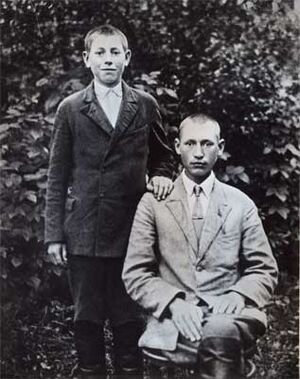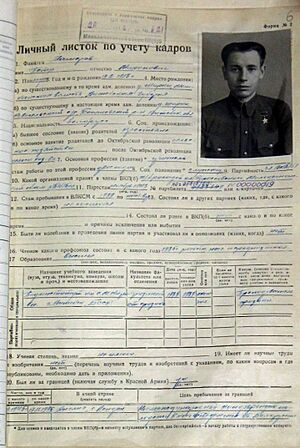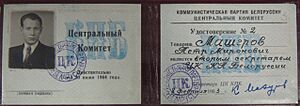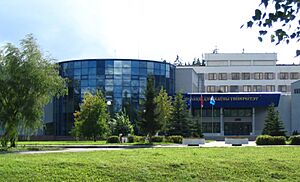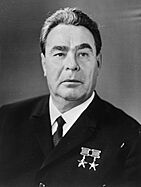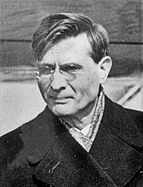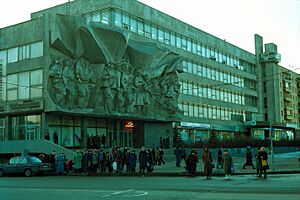Pyotr Masherov facts for kids
Quick facts for kids
Pyotr Masherov
|
|
|---|---|
|
Пётр Машэраў
|
|
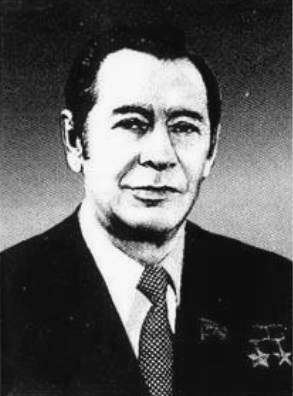
Masherov as shown on a 1996 stamp of Belarus
|
|
| First Secretary of the Communist Party of Byelorussia | |
| In office 30 March 1965 – 4 October 1980 |
|
| Preceded by | Kirill Mazurov |
| Succeeded by | Tikhon Kiselyov |
| Candidate member of the 23rd, 24th, 25th Politburo | |
| In office 8 April 1966 – 4 October 1980 |
|
| Personal details | |
| Born |
Piatro Mironavič Mašera
26 February 1919 Shirki, Western Oblast, Russian Socialist Federative Soviet Republic (now Belarus) |
| Died | 4 October 1980 (aged 61) Minsk, Byelorussian SSR, Soviet Union (now Belarus) |
| Political party | Communist Party of the Soviet Union (1943–1980) |
| Other political affiliations |
Communist Party of Byelorussia |
| Spouse | Polina Andreyevna |
| Relations | 3 sisters 1 brother |
| Children | Natalia, Yelena |
| Profession | Teacher, civil servant |
| Military service | |
| Allegiance | Soviet Union |
| Branch/service |
|
| Years of service | 1941–1945 |
| Rank | Major general |
| Battles/wars |
|
Pyotr Mironovich Masherov (born February 26, 1919 – died October 4, 1980) was an important leader in the Soviet Union. He was a partisan (a fighter in a resistance group) during World War II. Later, he became a top government official.
From 1965 until his death in 1980, Masherov led the Byelorussian Soviet Socialist Republic (which is now Belarus). Under his leadership, Belarus changed a lot. It went from being a farming country, still recovering from the war, to a strong industrial nation. Minsk, the capital city, grew very fast during this time. Masherov's rule ended suddenly when he died in a car accident in 1980.
Masherov was born into a farming family in what is now the Vitebsk Region of Belarus. In his younger years, he was a teacher of math and physics. After his father was arrested and died during a difficult time in Soviet history, Masherov joined the Red Army when Operation Barbarossa (the German invasion of the Soviet Union) began. He rose to the rank of major general. After World War II, Masherov entered politics. He became a top leader in the Communist Party of Byelorussia in 1965.
People knew Masherov for being humble and down-to-earth. This made him different from many other high-ranking Soviet officials. He was close to leaders who wanted to make changes in the Soviet Union. Many people in Belarus still admire Masherov today because the economy grew so much when he was in charge.
Contents
Early Life and Education
Growing Up in Belarus
Pyotr Mironovich Mashero was born on February 26, 1919. His birthplace was the village of Shirki, in what was then the Western Oblast of the Russian Soviet Federative Socialist Republic. Family stories say his great-grandfather was a soldier in Napoleon's army who stayed in Belarus. Pyotr's parents were Miron Vasilyevich Mashero and Daria Petrovna Lyakhovskaya. Pyotr had seven brothers and sisters, but only four lived to be adults.
School Days and Challenges
Getting an education was not easy for Masherov. He finished primary school, but only partly completed secondary school at first. He had to walk 18 kilometers (about 11 miles) to and from school. In winter, he used homemade skis. On weekends, Pyotr, his father Miron, and his brother Pavel worked part-time. They loaded logs onto railway cars.
His sister Olga remembered that in the early 1930s, their family struggled to get enough food. This was due to bad weather and problems with the new collective farms (called kolkhoz). Pyotr's sister Matryona, who lived in Vitebsk, helped them by sending bread and sugar.
In 1933, Masherov moved to Dvorishche, where his older brother Pavel taught history and geography. Pyotr went back to school and finished his secondary education in 1934. He then went to Vitebsk State University to become a physics and math teacher. He was very active in sports, especially skiing and skating. Masherov graduated in 1939 and started teaching that same year.
A sad event happened in 1937. His father, Miron, was arrested and accused of "anti-Soviet agitation." He was sentenced to ten years of hard labor and died soon after. Later, he was cleared of the charges because there was no proof. After this, Pyotr and Pavel had to support their family.
From 1939 to 1941, Masherov taught physics and math at a school in Rasony. Students liked him, and he was well-respected. He also helped with the school's drama club and even acted in some plays.
World War II Hero
In 1941, when Operation Barbarossa began, Masherov joined the Red Army as a volunteer. In August 1941, he was captured near Nevel and put on a prisoner train. Masherov escaped by jumping from the moving train in Rasony district. He got some bruises and scratches, but made it back to Rasony.
After his escape, Masherov started organizing a secret youth group called the Komsomol in Rasony. This group became an early part of the Belarusian resistance during World War II. From December 1941 to March 1942, he continued working on the farm and teaching. At the same time, he secretly organized the partisans in Rasony. During this period, the partisans found supporters and gathered supplies. One of their hiding spots was at the dentist's office in Rasony. The dentist was Polina Galanova, who later became Masherov's wife.
Using the secret name "Dubnyak," Masherov became one of the leaders of the Belarusian partisan movement. In April 1942, he became the commander of the N. A. Shchors partisan group. His fellow partisans chose him as their leader, and the main partisan headquarters agreed. In their first battle, Masherov was wounded. He chose to recover at the home of one of his former students, even though his soldiers disagreed.
He was wounded again later. In the summer of 1943, he joined the Communist Party of the Soviet Union. Around the same time, he was promoted to lead the Konstantin Rokossovsky Partisan Brigade. In September 1943, Masherov was promoted again. In 1944, he received the title of Hero of the Soviet Union. This was for being the "first organizer of the partisan movement" in his area, which grew into a huge uprising.
After the War: A Political Career Begins
After the war ended, Masherov started working in politics within the Komsomol. From July 1944, he was a top leader in both the Molodechno Region and Minsk Region. In October 1947, Masherov became the First Secretary of the Komsomol for the Byelorussian SSR. According to Vladimir Velichko, Masherov helped rebuild Molodechno. He also took part in efforts against Polish resistance groups.
Soon, Masherov moved from the Komsomol to the main Communist Party of Belarus (CPB). It is said that Nikolai Patolichev, then the First Secretary of the CPB, suggested this move. Patolichev was impressed by Masherov's work. On August 1, 1955, Masherov was elected as First Secretary of the Brest Regional Committee of the CPB.
In Brest, Masherov did similar things to what he would later do as the top leader of Belarus. He invested money in developing machinery and created a museum and memorial to remember the defense of Brest Fortress. Brest grew quickly, and Masherov also focused on traditional Belarusian culture. He invested in Belarusian musical instruments and books. In Brest, Masherov lived in a former Polish official's house and often walked to his office without security. Belarusian cosmonaut Pyotr Klimuk said that people in Brest respected Masherov greatly.
Leading Belarus (1965–1980)
Masherov had been the Second Secretary of the CPB since 1962, working under Kirill Mazurov. So, when Mazurov left his position in 1965, it made sense for Masherov to take over. However, the Soviet government suggested Tikhon Kiselyov as a possible replacement. But Masherov's friends in the CPB, many of whom were former partisans, supported him. He was appointed First Secretary on March 30, 1965.
Growing Belarusian Industry
Masherov's main goal as First Secretary was to expand Belarus's industry. He took office the same year as the 1965 Soviet economic reforms, and he strongly supported them in Belarus. Unlike other Soviet republics, Belarus often had public discussions about its economy. They even openly talked about problems.
While Masherov was in power, many new factories and businesses started. These included Grodno Azot and chemical plants in Novopolotsk and Gomel. One of the most famous projects during his time was building the Minsk Metro. The government originally planned to build a metro in another city, Novosibirsk. But Masherov wrote to the Soviet leader, and eventually got support for the Minsk Metro.
Masherov did a lot to modernize Minsk, the capital city. He quickly updated the city, which meant tearing down some old parts that had survived World War II. He later said he regretted this and wished they could have saved more of the old town. The Minsk Sports Palace was built, and Dinamo Stadium was updated for the 1980 Summer Olympics. The Vileyka-Minsk water system was also built, bringing running water to most of Minsk.
Farming Improvements
Under Masherov's leadership, Belarusian agriculture grew much more than before. He aimed to increase the grain harvest from 2.3 million tons to 9-10 million tons. He said Belarus needed to feed itself and other parts of the Soviet Union. His efforts were quite successful; by 1977, the grain harvest reached 7.3 million tons.
In 1974, Masherov surprised many by appointing biologist Viktor Shevelukha as the agriculture secretary. Shevelukha was a scientist, not a politician, which was unusual for such a high position. Many of Masherov's other appointments were also professionals rather than politicians.
Focus on Education
Since he used to be a teacher, Masherov cared deeply about education in Belarus, especially in sciences. He worked with scientists from all over the Soviet Union. Masherov worked hard to get modern equipment for schools and research centers. For example, he bought the first heart ultrasound machine for a research institute in Belarus.
Masherov also supported building more schools and universities. The Brest State Technical University, the Pavel Sukhoi State Technical University of Gomel, the Belarusian State University of Culture and Arts, and Polotsk State University were all built during his time. He also improved vocational education and supported more teaching of foreign languages and Belarusian culture.
Masherov kept good relations with the Komsomol (youth organization). He helped open the BSSR's Komsomol school, one of the first in the Soviet Union. However, he also worried about many young Belarusians leaving to work on Komsomol projects in other parts of the Soviet Union and not returning. He called this a "demographic crisis."
Remembering World War II
As a former partisan leader, Masherov strongly supported remembering World War II and the Belarusian partisans. Many monuments were built under his rule, such as the Mound of Glory, the memorial to the Khatyn massacre, and the Breakthrough monument. Masherov even helped design the first plan for the Mound of Glory. He also made sure that Belarus's contributions to the Soviet war effort were known throughout the Soviet Union. He successfully pushed for Brest Fortress and Minsk to be given the title of Hero City.
Possible Promotion and Challenges
Masherov was considered for several higher positions in the Soviet government. Some people, like the Washington Post, said he wanted to become the Soviet Premier after his mentor, Kosygin, died. Others even suggested he might become the top leader of the entire Communist Party of the Soviet Union. A 1977 CIA report also saw Masherov as a key member of a "Belorussian Faction" that the Soviet leader, Brezhnev, saw as a threat. However, Masherov's sister Olga said that Brezhnev and Masherov had a friendly relationship.
Masherov was an independent thinker. While many other leaders followed Soviet leader Leonid Brezhnev closely, Masherov often pursued his own path. He developed Belarus and frequently acted without asking Moscow for permission. There are different stories about his relationship with Brezhnev. Some say Brezhnev hoped Masherov would achieve higher office. Others claim Brezhnev was jealous of Masherov, who was truly loved by the Belarusian people.
Masherov also had a complex relationship with Mikhail Suslov, a powerful figure in the Communist Party. Suslov reportedly tried to stop Masherov from moving up. He invited Masherov to a big party meeting in 1971 and asked him to give a speech criticizing certain political ideas. This caused problems because other European communist leaders were there, and it hurt Masherov's political future. However, a 1977 CIA report suggested that Suslov, along with Premier Alexei Kosygin, actually supported Masherov against Brezhnev's growing power.
Sudden Death
On the evening of October 4, 1980, Masherov left the Communist Party building in Minsk to go to Zhodzina. His usual car had problems, so he took a different one. Masherov was sitting in the front passenger seat. Near Smalyavichy, his car crashed head-on with a potato truck. Everyone in Masherov's car died instantly. The truck driver was badly hurt and went to the hospital.
The Soviet government investigated the crash and said it was an accident. The truck driver, Nikolai Pustovit, was found guilty of breaking traffic rules and causing deaths. He was sentenced to 15 years of hard labor. However, his sentence was reduced in 1982, and he was released in 1985.
Masherov's funeral was held on October 8, 1980, in Minsk. Tens of thousands of people attended. However, only a few high-ranking Soviet officials were there. This was because the government told other Communist Party members not to attend.
Theories About His Death
Some people believe that Masherov's death was not an accident. They think he was killed on purpose by powerful Soviet politicians who feared his rising influence. Yuri Andropov is often named as the main person behind these alleged plans. Several Belarusian politicians, including former Prime Minister Vyacheslav Kebich and Masherov's daughter Natalia, believe that Masherov was assassinated.
Masherov's Lasting Impact
Masherov's influence is still strongly felt in Belarus. This is because of the economic changes he started and his focus on remembering World War II. He was responsible for building the Khatyn massacre monument, the Mound of Glory, and the Minsk Metro. Masherov also supported the making of Elem Klimov's film Come and See, even when others tried to stop it.
After his death, a new street in Minsk was named Masherov Avenue. In 2005, its name was changed to Victors Avenue. In 2018, a Belarusian political party suggested renaming the Minsk Metro after Masherov. They said it was because he worked so hard to get the metro built.
In a poll from June 2012, Masherov was chosen as Belarusians' ideal leader by 23.2% of people. This was more than current President Alexander Lukashenko (20.6%) and Russian President Vladimir Putin (19.2%). In earlier polls, Masherov was also very popular. In 1996, a large number of people (45.2%) saw him as an ideal leader.
Language and Culture Changes
One important discussion about Masherov's time is his role in the Russification of Belarus. This refers to the decline of Belarusian-language education and the increase of Russian-language teaching. People agree that Masherov did not support Russian nationalism. However, those who criticize him note that during his rule, power became more centralized, and the Russian language grew more common in Belarusian society.
Belarusian journalist Siarhei Navumchyk said that this change happened because Masherov was a "sincere communist" who believed in cultural mixing. He also noted that this process started before Masherov, under Kirill Mazurov. Another journalist, Vital Cyhankoŭ, said Masherov was "first place" among leaders in promoting Russification. However, Cyhankoŭ also pointed out that Masherov worked to protect and strengthen Belarusian-language literature.
Historian Natalya Chernyshova believes Masherov's decision to limit Belarusian-language education was influenced by his background. She said he was a great example of someone who moved up in society. Like Cyhankoŭ, Chernyshova noted that Masherov supported Belarusian writers. He worked to honor writers like Yanka Kupala, Yakub Kolas, and Maksim Bahdanovič, even when it was politically risky. Writer Aliaksei Karpiuk also said that Masherov helped him get his party membership back and fought against the government's targeting of writers.
Personal Life and Interests
Masherov was known for being friendly and willing to help others. Foreign diplomats who met him described him as "polite and smart." He loved ballet and theater and often went to performances. He also enjoyed reading, going to the banya (a type of sauna), and association football (soccer). He even cut short a vacation to watch football matches in Minsk for the 1980 Summer Olympics. Masherov often visited Białowieża Forest and loved flying. He flew 104 times in 1978 alone. His flights usually started very early, around 4:00 AM, and lasted all day with many stops.
Masherov's older brother Pavel became a major general during World War II. Masherov's oldest daughter, Natalia Masherova, later became a politician in independent Belarus. She ran in the 2001 Belarusian presidential election and was popular in polls. However, she withdrew after the current president criticized her.
Awards and Honors
- Hero of the Soviet Union
- Hero of Socialist Labour
- Seven Orders of Lenin
- Jubilee Medal "In Commemoration of the 100th Anniversary of the Birth of Vladimir Ilyich Lenin"
- Medal "To a Partisan of the Patriotic War" 1st class
- Medal "For the Victory over Germany in the Great Patriotic War 1941–1945"
- Jubilee Medal "Twenty Years of Victory in the Great Patriotic War 1941–1945"
- Jubilee Medal "Thirty Years of Victory in the Great Patriotic War 1941–1945"
- Medal "For the Development of Virgin Lands"
- Jubilee Medal "50 Years of the Armed Forces of the USSR"
- Jubilee Medal "60 Years of the Armed Forces of the USSR"
- Jubilee Medal "50 Years of the Soviet Militia"
- Order of Georgi Dimitrov (Bulgaria)
|
See also
 In Spanish: Piotr Mashérov para niños
In Spanish: Piotr Mashérov para niños


